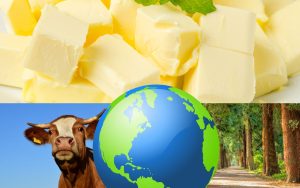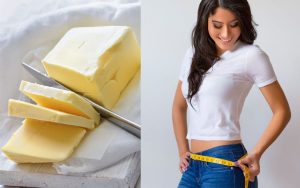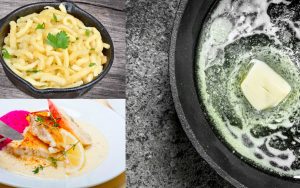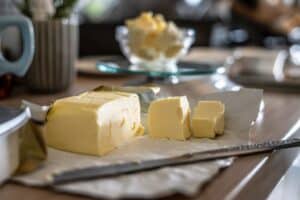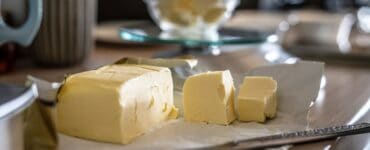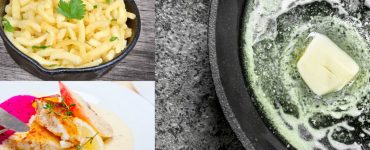In recent years, there has been a surge in popularity for plant-based alternatives to traditional animal products. One such product that has gained significant attention is vegan butter. With the rise of veganism and lactose intolerance, many individuals are opting for dairy-free options in their diet.
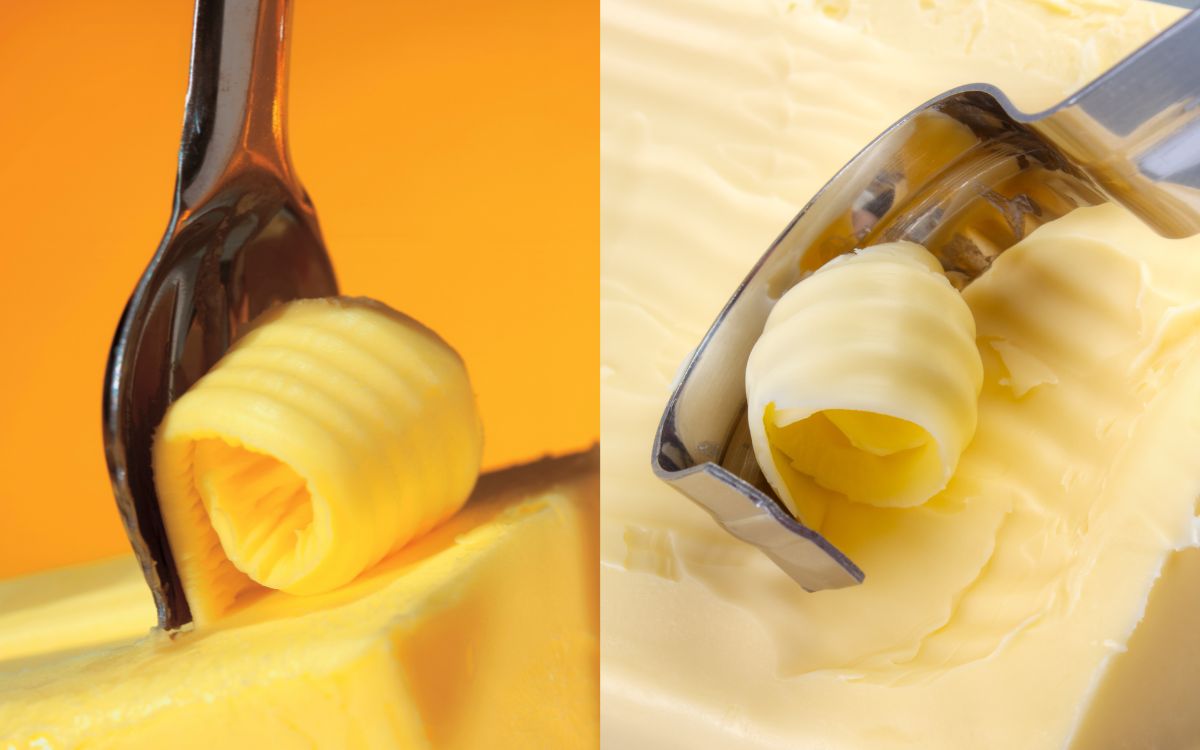
But how can you tell the difference between vegan butter and dairy butter? Whether you’re a vegan, lactose intolerant, or simply curious, this blog post will guide you through the characteristics and distinctions of vegan butter and dairy butter. By the end, you’ll be equipped with the knowledge to make informed choices and enjoy your butter guilt-free!
Identifying Differences in Taste and Texture
Flavor Profiles of Vegan Butter
Vegan butter offers a unique and diverse range of flavors that cater to various taste preferences. Depending on the brand and ingredients used, vegan butter can exhibit nutty, creamy, or slightly tangy notes.
Some varieties are infused with herbs, spices, or plant-based extracts to enhance the taste and create a delightful culinary experience. The absence of dairy in vegan butter allows the individual flavors of the plant-based ingredients to shine, resulting in a distinct characteristic that sets it apart from traditional dairy butter.
Taste Characteristics of Dairy Butter
Dairy butter is renowned for its rich, creamy taste that has been enjoyed for centuries. It carries the unmistakable flavor of milkfat, which provides a smooth and savory profile. The nuances in taste can vary depending on factors such as the animal breed, diet, and production methods.
From mild and buttery to robust and tangy, dairy butter offers a range of flavor intensities that add depth and complexity to various dishes. The richness of dairy butter has become a beloved staple in many culinary traditions.
Texture Differences
Texture plays a crucial role in distinguishing between vegan butter and dairy butter. Vegan butter tends to have a softer and more spreadable consistency, often resembling margarine. It is typically made from plant oils or vegetable-based fats, which contribute to its smoother texture.
This soft and easily spreadable nature makes vegan butter a versatile option for spreading on bread, toasting, sautéing, or incorporating into vegan and plant-based recipes. It also melts easily, providing a smooth and even distribution when used in baking.
In contrast, dairy butter is solid at room temperature and softens gradually when exposed to heat. Its firm texture allows for precise measurement and control when adding it to recipes. Dairy butter’s solid state makes it suitable for creating flaky pastries, laminated dough, and crumbly crusts. The gradual softening of dairy butter as it melts adds a distinct mouthfeel and creaminess to dishes, elevating their taste and texture.
Culinary Applications
The taste and texture variations between vegan butter and dairy butter significantly impact their culinary applications. Vegan butter, with its softer texture and unique flavors, works well in spreading on bread or toast, giving a delightful burst of flavor with each bite.
It is also ideal for sautéing vegetables, adding richness to vegan and plant-based recipes, and creating butter-based sauces that are free from animal products. Additionally, vegan butter’s ability to melt smoothly makes it a great choice for baking, ensuring even distribution and imparting a delectable taste to cookies, cakes, and pastries.
Dairy butter, with its rich taste and solid texture, remains a popular choice for traditional baking, pastries, and classic butter-based sauces. Its creamy richness brings depth and indulgence to recipes, making it an irreplaceable ingredient in many culinary traditions. From flaky croissants to buttery pie crusts, dairy butter’s firm texture creates a desired mouthfeel and imparts a distinct flavor that is hard to replicate.
Label Reading and Packaging
Understanding Product Labels
When distinguishing between vegan butter and dairy butter, reading and understanding product labels is crucial. Take the time to carefully examine the information provided on the packaging. Look for the ingredients list, nutrition facts, and any allergen warnings. By familiarizing yourself with the key elements of a product label, you can make informed choices that align with your dietary preferences and needs.
Vegan Labeling Guidelines
Many vegan butter brands make it easier for consumers by clearly indicating their vegan status on the packaging. Look for labels such as “Vegan,” “Certified Vegan,” or “Plant-Based.” These labels are often displayed prominently and act as quick indicators that the product is free from animal-derived ingredients. By recognizing these specific symbols or claims, you can identify vegan butter options that are suitable for those following a vegan or plant-based lifestyle.
Dairy Labeling Requirements
On the other hand, dairy butter packaging may not explicitly state its dairy origin, but certain labels and claims can help identify it as a dairy product. Look for terms like “Made with Real Butter,” “100% Butter,” or “Contains Milk.” These labels serve as indicators that the product is made from dairy sources. It is important to pay attention to such labels if you prefer or require dairy-based products in your diet.
Additional Packaging Indicators
Beyond the explicit labels, there are visual cues on the packaging that can provide hints about the type of butter. Vegan butter packaging often features imagery related to plant-based ingredients, such as fruits, vegetables, or botanical elements.
These visuals aim to emphasize the product’s plant-based nature and appeal to those seeking vegan options. On the contrary, dairy butter packaging may showcase images of cows, pastoral scenes, or traditional dairy farming, reinforcing its connection to dairy sources.
Practical Tips for Differentiating
Color and Appearance
One practical tip for differentiating between vegan butter and dairy butter is to pay attention to their color and appearance. Vegan butter tends to have a lighter, more pale yellow hue compared to dairy butter, which often has a richer, golden color.
Additionally, observe the texture and consistency. Vegan butter may have a smoother, more uniform appearance, while dairy butter might display a slightly grainy or marbled texture due to the milkfat content.
Smell Test
Engaging your sense of smell can also be helpful in distinguishing between vegan and dairy butter. Give each butter a gentle sniff to detect any distinctive aromas. Vegan butter may have a subtle, plant-based scent, often with a hint of the ingredients used, such as coconut or almond. In contrast, dairy butter carries a distinct, creamy aroma with notes of milkfat that are unmistakable.
Ingredient Scrutiny
Carefully reading the ingredient lists is an essential step in determining whether a butter is vegan or dairy-based. Look for key ingredients like oils, fats, emulsifiers, and flavorings. Vegan butter typically utilizes plant-based oils, such as coconut, olive, or sunflower oil, as a base.
On the other hand, dairy butter’s ingredient list will include milkfat or cream derived from cow’s milk. By examining the ingredients, you can identify the primary source of fat and discern the type of butter.
Taste Test
One of the most effective ways to differentiate between vegan and dairy butter is through a taste test. Take a small amount of each butter and try them side by side. Pay attention to the flavors and the sensations on your palate. Vegan butter may have a slightly different taste profile, with hints of the plant-based oils used in its production.
Dairy butter, on the other hand, will showcase the characteristic creamy and buttery flavors associated with milkfat. By comparing the tastes, you can discern the unique qualities of each butter.
Seeking Recommendations and Reviews
Another practical tip is to seek recommendations and read reviews from trusted sources or fellow consumers. Online platforms, food blogs, and social media communities often offer insights and experiences from individuals who have tried different brands and types of butter.
By tapping into these resources, you can gain valuable information and guidance to help you in identifying the differences between vegan and dairy butter.
Conclusion
In the battle of vegan butter versus dairy butter, both options have their unique qualities and purposes. Vegan butter provides a compassionate and sustainable alternative for those who choose to eliminate animal products from their diet. It offers a wide variety of flavors and spreads, making it a versatile choice for cooking, baking, and spreading on toast.
On the other hand, dairy butter continues to be favored for its rich, creamy taste and the familiar flavors it brings to traditional recipes. It also contains vitamins and nutrients like vitamin A and D, which can be beneficial for certain individuals.

